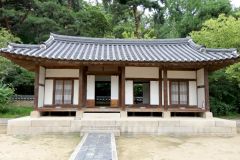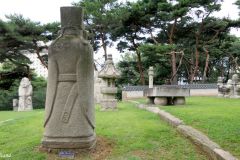Royal burial tombs have a five thousand years history in Korea. 40 royal tombs of the Joseon Dynasty are designated as world heritage, and I had the fortune of visiting three of most famous.
The UNESCO World Heritage List includes more than a thousand properties with outstanding universal value. They are all part of the world’s cultural and natural heritage.
Official facts
- Full title of site: Royal Tombs of the Joseon Dynasty
- Country: South Korea (Republic of Korea)
- Date of Inscription: 2009
- Category: Cultural
UNESCO’s World Heritage Centre’s (short) description of site no. 1319:
The Royal Tombs of the Joseon Dynasty form a collection of 40 tombs scattered over 18 locations. Built over five centuries, from 1408 to 1966, the tombs honoured the memory of ancestors, showed respect for their achievements, asserted royal authority, protected ancestral spirits from evil and provided protection from vandalism. Spots of outstanding natural beauty were chosen for the tombs which typically have their back protected by a hill as they face south toward water and, ideally, layers of mountain ridges in the distance.
Alongside the burial area, the royal tombs feature a ceremonial area and an entrance. In addition to the burial mounds, associated buildings that are an integral part of the tombs include a T-shaped wooden shrine, a shed for stele, a royal kitchen and a guards’ house, a red-spiked gate and the tomb keeper’s house. The grounds are adorned on the outside with a range of stone objects including figures of people and animals. The Joseon Tombs completes the 5,000 year history of royal tombs architecture in the Korean peninsula.
My visit
Even though there are 40 tombs in 18 locations (learn more), they are all in or near Seoul. In 2019 I visited a park in the Gangnam district of Seoul, the Seonjeongneung. This is a combined name of Seolleung and Jeongneung. It contains the burial mounds and tombs of King Seongjong (1495), King Jungjong (1544) and Queen Jeonghyeon (1530). The queen was Seongjong’s second wife and Jungjong was their son.
To get here, take metro/subway line 2 to Seolleung Station, and walk 350 metres to the park entrance. The first mound you will find is that of the son. There is a red-spiked gate, a stone-paved walkway with two lanes – one for the spirit of the deceased and the other for the living king. Then there is a pavilion and behind it the mound. This goes for the mounds of the two kings. One is not able to climb the two large mounds of the kings. This is a pity, because we can see the heads of several statues on top of the mounds.
On the other hand, when we continue the walk in the very beautiful park, the reward is the queen’s tomb. Here it is possible to climb up on level with the top of the mound. Several statues of animals and humans are close by, but we are still not able to touch them.
Browse to the PREVIOUS or NEXT post in this series.














